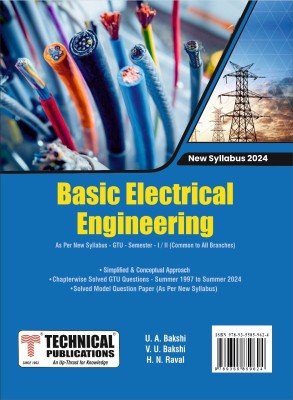Basic Electrical Engineering for GTU 24 Course (I/II- COMMON)(Paperback, U. A. Bakshi, V. U. Bakshi, H. N. Raval)
Quick Overview
Product Price Comparison
Syllabus Basic Electrical Engineering Total Credits L + T + (PR/2)Assessment Pattern and MarksTotal Marks CTheoryTutorial / Practical ESE (E)PA/CA (M)PA/CA (I)ESE(V) 470302030150 Unit No.Content 1.DC Circuits : ŌĆóElectrical circuit elements (R, L and C), voltage and current independent sources, KirchoffŌĆÖs current and voltage laws, analysis of simple circuits with dc excitation, Superposition, Thevenin and Norton Theorems, Star-delta / Delta-Star conversion, Time-domain analysis of first-order RL and RC circuits. (Chapter - 1) 2.AC Circuits : ŌĆóRepresentation of sinusoidal waveforms, peak, RMS and average values of different signals, form factor and peak factor, Phasor representation of AC quantities, real power, reactive power, apparent power, power factor. ŌĆóAnalysis of single-phase ac circuits consisting of R, L, C, RL, RC, RLC combinations (series and parallel), Series and parallel resonances, Three phase balanced circuits, voltage and current relations in star and delta connections, Power measurement in three phase balanced circuits. (Chapters - 2, 3, 4) 3.Magnetic Circuits & Transformers : ŌĆóMagnetic effect of electrical current, cross and dot convention, right hand thumb rule and cork screw rule, Concepts of m.m.f, flux, flux density, reluctance, permeability and field strength, Analogy between electric and magnetic circuits, Magnetic Circuits, B-H Curve, Hysteresis Loop, Hysteresis and Eddy current losses, Construction and working principle of single-phase transformers : Construction, principle of working, voltage and current ratios, losses, definition of regulation and efficiency, Ideal and practical transformer. (Chapters - 5, 6) 4.Fundamentals of Electrical Machines : ŌĆóGeneration of rotating magnetic fields, Construction and working of Single-phase induction motors (Split phase, Capacitor start, Permanent split capacitor, Capacitor start / capacitor run). ŌĆóSingle phase induction motor applications : pumps, refrigerators, fans, compressors and portable drills. ŌĆóConstruction and working of brushless DC motors and its application : Electrical Vehicle, washing machines, Blowers, Computers / Laptops. (Chapter - 7) 5.Electrical Wiring and Installations : ŌĆóComponents of LT Switchgear : Switch Fuse Unit (SFU), MCB, ELCB, MCCB. ŌĆóTypes of lamps, fixtures & reflectors, illumination schemes for domestic, industrial & commercial premises, Lumen requirements for different categories. ŌĆóEarthing - Types of earthing and its importance. ŌĆóSafety precautions for electrical appliances. ŌĆóTypes of Batteries, Characteristics of Batteries (Voltage, storage capacity, discharge curve, cycle life). ŌĆóElementary calculations for energy consumption of home appliances and electricity bill. ŌĆóBasic electrical measurements with Ammeter, Voltmeter, Wattmeter and Energy meter (working principle and circuit connection). (Chapters - 8, 9)


